The rolling stock shown on this page represents cars of length 20' - 30', with the majority being 23'. The images seen here will be updated as construction progresses.
As at 20-Oct-06 I have 10 operable cars (i.e. with trucks and couplers, although possibly needing further details/paint to complete), plus a further 14 cars in various stages of construction.
|
|
| Boxcars (8) | |
| All Wood construction | |
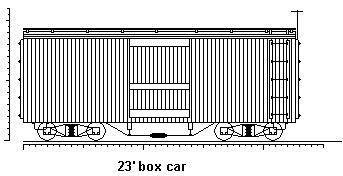 23' wood boxcar
23' wood boxcar
This is a car that I am scratch building from styrene sheet and strip, with Grandt Line trucks and details. It is based on boxcars 21 & 22 which ran on the Kennebec Central in Maine, although my model will be different in two repects; a) my car will represent a shorter car at 23' long, and b) the ladders on my car will be to the right, which will be the standard on my stock. The roof has now been added - at the second attempt. For the first try I had made the roof pitch such that centre was higher than the edges by 2mm, but this was far too steep. The rebuilt version now has a 1mm pitch. The next tasks for this car are to add a brake wheel and to begin preparing the roofwalk. |
|
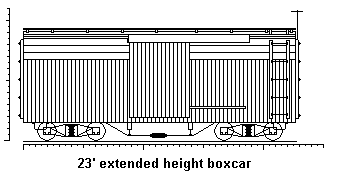 23' wood extended height boxcar
23' wood extended height boxcar
This is a scratch built car based on examples used on the Wiscasset, Waterville & Farmington. The prototype cars were originally built with a low roof, but were later rebuilt with the roof raised. The cars were not resheathed, but simply had the gap between sides and roof crudely filled with horizontal planking. The model uses Evergreen scribed sheet for the lower sides, with the upper boards being represented by individual styrene strips. If the upper boards do not line up correctly then so much the better, as this is exactly how the real cars looked! The planking is just about visible on the full size image of this car, but will hopefully show up a lot better after painting. |
|
|
28' wood boxcar
This car is a conversion I completed some time ago using an HO Bachmann 34' Old Timer boxcar body. The original car had a one piece body moulding, which included the roof. I cut a slice lengthways from the body to get the correct width, and then from each of the sides I removed the section including the door openings to reduce the length (NB: I did also start another car which I left full length at 34', which is accurate for the longest boxcars used on the Maine two foot gauge lines). The four pieces were then reassembled - how well this works depend on how accurate the parts were cut and trimmed. The doors are from the original model, there is no longer a door opening behind them so I have glued them shut and rebuilt thiner door guides. The roofwalk was not easily reusable and was replaced with one from styrene strip. The chassis is scratch built and uses trucks from a Welsh narrow gauge kit. Currently the car has KD couplers, but I plan to change these for DGs in line with my other stock. |
|
|
28' Wood boxcar, sliding door
Car built from a Chivers kit. Unusually for me, this one is built almost as per the instructions, although I have added Grandt Line turnbuckles (which required the use of a thinner filament for the truss rods). Still needs trucks fitting and couplers before it can be operated on the layout. |
|
| Composite construction | |
|
23' composite boxcar
This conversion began with a European outline van which I bought from a swapmeet. The sides and ends were separated, with the sides shortened to around a scale 23' and the ends narrowed to give an overall width of around 7'. The parts were then assembled around a new floor. Because I want this model to represent a car having a black canvas roof and an unpainted but weathered roofwalk planks, and the fact that these planks are easier to paint before being fully attached to the car, the assembly/painting sequence becomes a bit more complicated. The sequence I used was; assemble the roofwalk supports & centre plank, paint all roofwalk planks (including those not yet on the car), paint & weather the roof, finally add the outer two planks and end platforms. Update 12/01/2006: this car now has couplers fitted to both ends. |
|
| All steel construction | |
|
23' all steel boxcar, plug door
This car is a quick conversion from a Bachmann N scale car, based on a 40' steel hi-cube boxcar. The extra height of these cars brings them up to a suitable height, so conversion is limited to widening the car. New ends have been built from plasticard and strip, and the roof filled before the addition of a roofwalk. The roofwalk is from an old Athearn HO reefer and is rather too thick which shows up especially badly on a smaller narrow gauge car. The D&H decals were some I had in stock but they did not go on too well because they were quite old and tended to crack rather than settle around the details. Note that on this car the original N gauge chassis has been retained, although the N scale couplers have been removed from the trucks. Update 30/11/2005: This car now has DG couplers fitted. |
|
|
23' all steel boxcar, sliding door
This is another conversion based on a Bachmann 40' High Cube boxcar, this time with a sliding door rather than a plug door. Whilst basically similar to the car above I have made one significant change to the chassis. On the above car the original chassis was retained in its entirety. On this car I have kept only the trucks, and mounted them on scratch built bolsters as I did for the steel gondola cars. The result of this is that the car will ride lower, more in keeping with my other stock. If this works out well then I may rebuild the previous car using the same method. |
|
|
20' all steel boxcar
This car is a conversion from a OO steel van, which I bought as a body only from a model railway exhibition sales stand. This car uses the sides and ends which were separated from the original van. The side were left full length, but the end were narrowed such that the width matches my other stock. The sides and ends were then assembled around a new floor, and a scratch built roof added. Next to do on this car will be to start painting and add a roofwalk. The trucks will be mounted on scratch built bolsters as per my other stock. |
|
| Reefers (1) | |
|
28' all steel reefer
This is a 'what if' model, as in 'what if the two foot gauge lines had prospered beyond the time they actually did, and needed to develop new rolling stock?' With modellers licence in hand I have built this car as a modern narrow gauge steel reefer. The conversion started with a European van I picked up from a swapmeet. For this model the sides of the van are the only parts I actually used. The first task was to separate the sides from the original one piece body. I then cut a floor and two ends from plasticard and reassembled the body with a scale 7' 6" width to match my other stock. The ends were built up using Evergreen strip to simulate a reinforced welded steel end. On this car I decided to cut the top of the ends level and then set the pitch on the roof using internal supports, and then fill in the gap at the car ends later. This was an experiment because I thought this may be an easier method than cutting the ends to the correct profile. This method seems to have worked well, and I will probably use it on other cars. Painting is progressing slowly on this car. In the photo the ends and roof have received one coat of paint, but will need another to finish. On this car I plan to paint the ladders separately and then add them to the car afterwards. |
|
| Flat Cars (1) | |
|
This is a generic flat car based on the Sandy River & Rangeley Lakes cars, but built to a scale length of 23' so as to fit with the other cars I am building.
The decking is a piece of Slaters scribed plasticard and the chassis is styrene strip from both Slaters and Evergreen. The car originally rode on trucks borrowed from a Chivers HOn30 kit, but has now been fitted with Grandt line trucks and NWSL wheelsets. The details on this car - queen posts, end bolts - are Grandt Line parts. The car still needs truss rods and a brake wheel to finish. NB: The next page details the steps needed to build this type of car |
|
| Gondolas (5) | |
| All Wood construction | |
|
This car was built from a Roger Chivers kit.
I actually finished this car some time ago, but it was left 'on blocks' whilst its trucks were borrowed for use under a scratch built flat car. The flat car now has trucks to call its own, so this car could be put back together. I built this car as a 'converter car', with a DG coupler at one end and a KD coupler at the other, to allow cars with both types of coupler to operate in the same train. |
|
|
This model is based on the coal carrying gondola cars used on the Kennebec Central.
These cars had top hinged doors in the lower sides to simplify unloading.
The body for this car is scratch built from styrene, using scribed sheet for the wood deck and assorted strip for the chassis and body parts. Paint has been appled to represent a worn appearance by firstly painting the whole model in a weathered wood colour and then dry brushing a thin coat of paint over this to allow the wood colour to show through. To finish this car I will use Grandt Line trucks, and also add a coal load. |
|
| All steel construction | |
|
These cars are based on Bachmann N scale 42' steel gondolas, which I have widened out to a HO scale 7' width.
Initially I had kept the original chassis, but this did leave two problems with overall proportions. Firstly was that the trucks were too near the end of the car. Secondly the body rode too high for a narrow gauge car. Of these problems the spacing could have been cured by cutting a section from the centre of the chassis to move the trucks in, but there was no easy way to fix the ride height. For this reason I have now replaced the N scale chassis with bolsters built from plastic strip. The wheelbase of the N scale trucks are a little short in HO, but this is not too visible on such a low riding car. I have finished the first car with a rusted effect, covered in the Hints & Tips section. Since writing that tip I have developed a method to apply rust over lettering (so as to appear as though it has rusted through). I will most probably try that on this car, and if it works out I will update the hints & tips section. Due to the construction methods I employed not including a full floor this car will need a permanent coal load - the later cars now do include a detailed floor so can be completed as unloaded cars. The second and third cars have been painted to represent newer, less rusted, cars. The second car has been lettered using Woodland Scenics dry transfers. Some light weathering will be needed to be applied over this lettering to tone down the brightness. All the above cars still need details, including side ladders, steps and brake wheels. Future plans are to build a fleet of steel gondolas, both loaded and unloaded. For these I will be using further 40' N scale cars, as above, and also N scale 50' cars (which will represent 28' in HO scale). |
|
|
Other cars in progress but not yet photographed; 1. Car 23: Medium side wood gondola converted from a Lyton & Barnstaple 009 kit. Side stakes added and curved ends changed to square. Scales out to about 30'. 2. Car 24: Another 23' steel gondola based on a Bachmann N scale cars, as per the three above. |
|
| Tank Cars (1) | |
|
This tank car was constructed using the chassis and tank from an N scale Model Power car.
I don't think many narrow gauge lines, if any at all, ran 3 dome tank cars but this is just modeler's licence in action again! The original car had a steel frame chassis, I separated the tank from the chassis, trimmed away most of the framing, and inserted a wooden floor between them to simulate a tank mounted on a wooden flat car. The narrow gauge effect was strengthened by making the decking 7' wide. This car still needs details including truss rods/queen posts, brake wheel, hand rails and a ladder. Update 11/02/2005: This car now has couplers fitted and can be operated on the layout. |
|
|
Other cars in progress but not yet photographed; 1. Car 17: Another car never seen on the narrow gauge - a wooden bodied vinegar tank car. This will have two horizontal tanks on a flatcar body. |
|
| Open Hoppers (3) | |
|
|
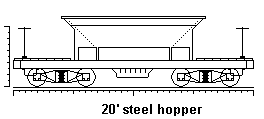 These cars are a combination of a hopper from an N scale car plus a scratch built chassis.
These cars are a combination of a hopper from an N scale car plus a scratch built chassis.
The cars are freelance and are inspired by the open hopper cars running on the Gilpin Tramway in Colorado, although they do have many differences from those cars. The hoppers on these cars are taken from N scale Atlas short hopper cars, which have been trimmed of all chassis and end platform details. The Atlas cars also provided the trucks. The chassis are scratch built using Evergreen strip of various sizes. On these cars I experimented with a rusted yellow paint (using method 1 in the hints & tips section). At first I feared that a bright colour may appear 'too clean' for a hard working car, however it was more of a problem to avoid ending up with a car that looks like it should have been condemed! I have tried to vary the degree of rust from car to car to represent cars of differing age. The first car has end platforms made from real wood - basswood strips stained with thinners and black enamel before being cut to length and attached. This was the first time I have used the method on US outline stock, it worked so well that I will also consider using it for any future flat cars that I build. I plan to build further cars using the same technique. I will also build other cars using similar, but not quite identical, N scale hopper bodies so as to add some extra variety in a long train, as though the cars had been constructed by different builders. |
| Other Cars (3) | |
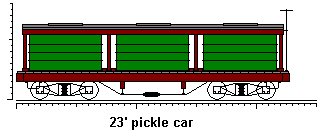 This car is, at the moment, an exact copy of the scratch built flat car shown above.
I plan to finish it as a pickle car.
This car is, at the moment, an exact copy of the scratch built flat car shown above.
I plan to finish it as a pickle car.
To the best of my knowledge none of the narrow gauge lines actually owned a pickle car - but that is just modeler's licence in action (yet again!). The pickle cars that were used on the standard gauge usually had 4 tubs, but the chassis proportions of the cars that I am building will better suit 3 tubs, so that is how I will construct this car. I tested the height of the tubs using a paper/card mock up. This proved to me that the height that I would have built them gave a car too high for the look I was intending, so I have changed the plans to give a lower overall car height. I hope to be able to form the tubs by rolling 1mm scribed plasticard around a suitable cylinder and then setting it to approximate shape by immersing in hot water - watch this space to see how it turns out. |
|
|
This car is based on a generic style of car that was widely used in the logging industry.
As built, using N scale trucks with bolsters cut from an N scale chassis, it does ride a little high - although as prototype were build in a variety of styles it is probably not far off correct for some car that was actually built. The skeleton body is built from assorted plastic strip (Slaters and Evergreen), and includes Grandt Line details for the bolts and washers. Time will tell whether this car will be too light to operate in a train. If so there is very little space to hide any weight so it may need to be run permanently loaded with a 'heavy weight' log. The car still needs some detailing, including chocks on the bolsters which would have held the logs in place, and a brake wheel. Update 24/11/2006: This car now has couplers fitted to both ends, and the steel bolsters have been completed, painted and weathered. |
|
|
28' drop centre flatcar
This car is a conversion from an Atlas N scale 50' car. I had originally planned to separate the body/chassis unit into three lengthways and then reassemble the parts under a wider floor. This would have enabled me to retain the original built in bolsters for truck mounting. However when I tried this I ran into the same problem as I had with my first Bachmann boxcar conversion - that the car was left riding too high. I have therefore used just the outer part of the original chassis under the new floor, built from scribed plasticard, and have built bolsters similar to those on my other stock. The attachment to the bolsters needed to be slightly different on this model due to me retaining the original 6 wheel trucks. Had I used the same method that has worked for the other cars then bolt head and the centre axle would try and occupy the same space. Instead I had to arrange for the bolt head to sit within the hole in the bolster by attaching a 'washer' to the top of the bolster. |
|
DG Couplings
When initially planning the layout I had been planning to use Kadee couplers and magnets - simply because this is 'what one did' when modeling US outline stock.
This changed when, between the planning stage and beginning to build the rolling stock, I had constructed some 009 wagons for a different layout. I had fitted these cars with DG couplers.
I decided to use DG couplers on my US outline stock for the following reasons;
- Compatability with my 009 stock
- Ease of attaching couplers
- They are designed to be used with a basic electromagnet (as oppose to the complicated design required for Kadees)
- To uncouple stock in a train being pulled over a magnet a slight slackening of the couplers is all that is need to activate the delay, rather than the Kadee signiature 'dance over the magnet' routine.
- While propelling stock over the magnet the delay can be activated with the train in motion.
- A further advantage I have since found out, you can use DGs + electromagnets without needing to upgrade all your rolling stock to non-magnetic wheels/axles. A big plus when you have a collection of stock based on a variety of trucks.
I have constructed my couplers with a loop at one end of the car and a tongue at the other, rather than the recommended approach of a loop and tongue at both ends. This limits the complexity of construction, simplifies the positioning over a magnet, and probably improves operation. On the down side it does mean that stock can never be turned, so would not be a suitable method for any layout with a turntable or any reverse loop or wye.
DG Couplings are now manufactured by Model Signal Engineering.
And finally....
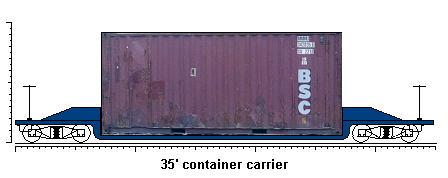
Just to prove once and for all that my sense of humour does not have sensible limits! Who knows, if the narrow gauge lines had lasted long enough then they may have done something like this - after all the 3' gauge East Broad Top did carry trailers on adapted flat cars - although I dread to think what it would have done to the 35lb/yard rail!
Will I ever build it? Watch this space to find out!